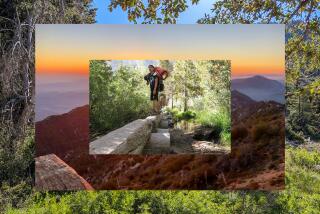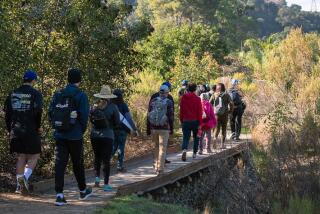CLIPBOARD
Northwest Fullerton is located in the Coyote Hills, which were named for a once-common inhabitant. Today, there are few coyotes and plenty of houses and people. But the area’s spacious homes, built around Ralph B. Clark Regional Park and Los Coyotes Golf Course, provide an elegant, uncrowded atmosphere.
The neighborhood includes one of California’s major paleontological study sites, an area yielding fossils older and more varied than the better-known La Brea Tar Pits in Los Angeles. The site, located in Ralph B. Clark Regional Park, has provided paleontologists with more than 63,000 marine and terrestrial fossils in a six-year period. The park’s Interpretive Center is one of only five on-site paleontological museums in the world.
“This site isn’t as well known as the La Brea Tar Pits, but the fossils here are much older,” said Steven Conkling, a ranger and paleontologist at the park. “La Brea dates back 400,000 years, but we commonly find things here that are over 1 million years old. La Brea has only terrestrial fossils, but here there are terrestrial and marine specimens as well,” Conkling said.
A volunteer program provides amateur paleontologists an opportunity to conduct fossil digs and learn laboratory work. The excavation sites are sectioned into plots, and some volunteers come almost every day to scratch around in their assigned areas, hoping for a rare find.
It’s not unusual to come across fossilized llama, saber-toothed tiger, whale and dolphin bones as well as million-year-old sea turtle shells and the fossilized remains of 16-inch banana slugs. “Can you imagine such a thing? There must have been a lot of them here,” said Conkling. “Which tells us that the area was once very moist, unlike today’s dry environment.”
“Paleontology is very exacting work that takes a lot of dedication,” said Conkling. “The volunteers do more than just help. They do actual research, just like professionals.”
Several Northwest Fullerton residents participate in the paleontology program, including Stan Kuran, who lives within walking distance of the park on Via Linda. “I’ve always been interested in paleontology, even though it’s not my profession,” said Kuran, 43. “I started reading up on the subject when I was a kid and living near the center gave me a chance to see everything firsthand,” he said.
Spending time at the dig site encouraged 16-year-old Brian Kussman to plan a career in paleontology, and even though he’s still in high school, he has already published an article on his findings in the California Academy of Sciences Journal. “Brian will be a top-notch paleontologist some day,” said Conkling. “I helped him learn the basics of fossil identification and now he’s better at it than I am. I wish I’d had this kind of learning environment available when I was in high school.”
The park is also one of Orange County’s foremost bird habitats and the local Audubon Society conducts an annual bird count here. Portions of the park that were previously trimmed and mowed have been allowed to return to a more natural state in order to provide a better habitat. It’s not unusual to see red-tailed hawks swooping through the sky while joggers wind their way around the park’s numerous trails.
The park’s dedication to preserving the environment is lauded by residents who have tolerated bad publicity and foul odors generated by the McColl Dump Site, located adjacent to the park on Sunny Ridge Drive. The eight-acre dump was used as a disposal site for oil refinery sludge and toxic wastes left over from the production of high-octane aviation fuels during World War II. It is known to contain arsenic, benzene and sulfuric acid.
When the area was developed in 1978, the city and developers failed to inform home buyers of the potentially harmful dump located just a few hundred feet from their homes and underneath a portion of Los Coyotes Golf Course. As a result, two rounds of lawsuits have been filed and more than $24 million in settlements from developers and oil companies awarded to residents.
Several plans to seal off, incinerate or haul away the toxic sludge have fallen through, since oil companies disagree with federal officials on who should foot the bill. The Environmental Protection Agency has placed the area under 24-hour armed guard and conducts regular tests for ground water contamination.
“This has gone on for too long,” said Steve Clark, who works at Hughes Ground Systems, the neighborhood’s largest employer. “I wish they’d decide what to do about this mess so we can be rid of it. This is my home. I don’t like the fact that such a beautiful neighborhood is known mostly for its toxic dump site,” he said.
Population Total: (1990 est.) 6,876 1980-90 change: +24.3% Median Age: 34.2
Racial/ethnic mix: White (non-Latino): 57% Latino: 11% Black: 1% Other: 31%
By sex and age: MALES Median age: 33.8 years FEMALES Median age: 34.5 years
Income Per capita: $22,860 Median household: $60,086 Average household: $62,624
Income Distribution: Less than $25,000: 12% $25,000-49,999: 23% $50,000-74,999: 37% $75,000-$99,999: 14% $100,000 and more: 14%
More to Read
Sign up for Essential California
The most important California stories and recommendations in your inbox every morning.
You may occasionally receive promotional content from the Los Angeles Times.










